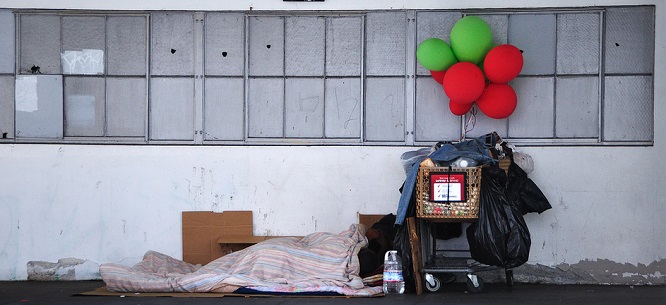Let Them Eat Code
Let Them Eat Code
In the tech community, the plight of homeless people has gone from being an unnoticed barnacle of urban life to a cause at once mourned, criticized, and celebrated. For many in Silicon Valley, homeless people are the “noble savages” of today.

Late last year, a Bay Area entrepreneur named Greg Gopman took to Facebook to share his feelings about one of American society’s most stubborn problems: homelessness. “There is nothing more grotesque than walking down market st. [sic] in San Francisco,” wrote Gopman, the CEO of a tech marketing company called AngelHack, in a much-circulated post. “Why the heart of our city has to be overrun by crazy, homeless, drug dealers, dropouts, and trash I have no clue.” He went on:
There is an area of town for degenerates and an area of town for the working class. There is nothing positive gained from having them so close to us. In other cosmopolitan cities, the lower part of society . . . sell[s] small trinkets, beg[s] coyly, stay[s] quiet, and generally stay[s] out of your way. They realize it’s a privilege to be in the civilized part of town and view themselves as guests. And that’s okay.
Gopman isn’t the only Silicon Valley entrepreneur who has publicly expressed disgust for San Francisco’s roughly 6,500-strong homeless population in recent months. Peter Shih, an entrepreneur who was admitted to the prestigious Y Combinator “incubator” for promising young companies, wrote that “San Francisco has some of the craziest homeless people I have ever seen in my life” in a blog post last year. “I’m seriously tempted to start fucking with people and pay for homeless guys to ride the Powell street cable cars in the middle of the day, that ought to get the city’s attention.”
Both Gopman and Shih apologized after they were lambasted by bloggers and commenters. But their remarks struck a chord: their repulsion, and disregard for the very real problems plaguing hundreds of thousands of homeless people in the United States, channeled an insensitivity that’s native to a subset of successful businesspeople who believe they secured their venture capital or their hot wives because of merit and not luck, privilege, or circumstance. The homeless, therefore, make easy targets. If they can’t even get their acts together to house and bathe themselves, let alone build apps, why should they be allowed into parts of town where the nice people go?
Gopman and Shih’s spite reflects an unsurprising attitude in increasingly unequal San Francisco (and New York, Boston, and Austin). Still, the tech world’s attitude toward homeless people is far from one-dimensional. Over the past couple of years, the plight of homeless people went from being an unnoticed barnacle of urban life to a cause at once mourned, criticized, and celebrated by prominent members of the technology community. Throughout the discussions that ensued, homeless people emerged as symbols not of how society has failed its poorest members, but of what life is like before society steps in. This idea lies behind the tech world’s fascination with, and flawed approaches to alleviating, the problem of homelessness.
It’s hard to tell exactly when this obsession with the homeless began. No doubt a combination of income inequality, high housing prices in urban centers where tech professionals and the journalists who cover them live, and tough economic conditions played a role in bringing about greater awareness of the problem. San Francisco now has the highest median rent ($1,463 for a one-bedroom) in the country, according to U.S. Census figures, narrowly beating San Jose ($1,441), Washington, D.C. ($1,236), Boston ($1,260), and New York ($1,187). Just 9 percent of all units in San Francisco rent for $750–$999, which makes it hard for middle-income earners, let alone the poor, to find an affordable place to live. Perhaps this newfound preoccupation was partially the result of confused soul-searching: entrepreneurs might finally be growing tired of making Facebooks for cats and Ubers for helicopters, and looking to invest their time in more worthy causes instead. Whatever the root of the concern, it was at Austin’s South by Southwest music, film, and tech festival in 2012 that homeless fever took a firm hold.
That year, the “innovation lab” of an ad agency at the festival decided to improve Internet access around Austin with a novel “hack”: employing homeless people as Internet providers. The firm carefully vetted individuals from a pool of homeless locals; attached small devices to them that allowed users to connect to the web through the 4G phone network; and gave them T-shirts to wear while they stood, sat, or walked around. One of these shirts read, “I’m Clarence, a 4G hotspot,” followed by a number to text to donate money. The size of the donation was up to the wireless user’s discretion, but the suggested sum was $2 per fifteen minutes.
The stunt was met with curiosity and outrage. Bloggers at Valleywag and the New Republic (to name just a couple) had a field day; advertising strategists called it cruel—a “shameful, hideous, patronizing and dehumanizing idea,” according to one ad man quoted in the press. The agency and its supporters contended that they were just trying to help and compared carrying Wi-Fi to selling newspapers, something that homeless folks have been doing for decades. After all, in both cases, the homeless person acts as a “content provider.” Clarence, for the record, had no problem with his role—“it’s a job,” he told the New York Times. Clarence’s thoughts were, naturally, beside the point, to both proponents and critics.
A more recent controversy ensued this past fall, when a New York engineer named Patrick McConlogue encountered a homeless man, Leo, on his way to work. (Homeless people in these stories, it is worth noting, are almost always referred to by their first names, while their tormentors, or benefactors, are afforded the dignity of a surname.) When McConlogue “found” Leo, Leo was in a park engaging in some approximation of CrossFit, “doing lifts by throwing [chains] over his neck” in a “movie-poster worthy” scene, according to McConlogue. Leo, McConlogue makes clear, was no ordinary homeless guy but “unjustly” homeless. Seeing him gave the engineer the same feeling as “when you know the waiter, the cashier, the janitor is in the wrong place—they are smart, brilliant even.”
The impoverished existence of homeless people provides an opportunity to pass judgment on the human condition.
What followed reads like a twisted fable. Our impresario came back the next morning and gave Leo a choice: accept a one-time gift of $100 or take computer programming lessons every morning for no cost.
Leo chose code, and for the next eight weeks, his mentor helped him build a carpooling application. Leo got arrested halfway through the experiment—the day before he was slated to appear on the “Today Show” on NBC, no less—for sleeping on a park bench after the park had closed to the public. That’s what happens when you’re homeless; all the code in the world won’t help you with the cops. But Leo pulled though and finished his project, and he appears to still be working with McConlogue, to some success and much acclaim: the project lent some credence to the idea of tech as the perfect bootstrap for people to haul themselves out of poverty and into fame and fortune.
There are also tech workers who would rather learn from homeless people. Last year the founder of the photo-messaging app Snapchat apparently bragged to a fellow entrepreneur about testing his product on “RANDOM people—like homeless people” and using their uneducated reactions to improve his product.
Zach Verdin, the CEO of a publishing platform called NewHive, later went beyond simple product testing in his bizarre analysis of the lessons evolutionarily advanced humans can learn from homeless peoples’ shopping carts. “Like #Hashtags on Twitter homeless people have re-imagined how to use the product and have turned Shopping Carts into mobile storage units, houses, fire pits, plant beds, and so many other things,” he wrote. “By taking shopping carts, personalizing them, and walking the streets they’re actively encouraging other homeless people to use shopping carts.” The takeaway? “Get people to create content that they’re proud of and when they do that it’s natural that they want people to see it.”
Then, in October, a Seattle businessman began organizing three-day, $2,000 “homeless tours” to show customers “a crash tour of the homeless life style,” as though their rootless, minimalist ways were a business strategy to be considered (after all, “mobile” is the future). A few months later, employees of Greg Gopman’s AngelHack (but not Gopman himself) were photographed next to a homeless man, apparently “learning” about what it’s like to live in the streets.
The homelessness obsession extends beyond mere talk and tourism. In lengthy online discussions, Bay Area tech workers describe their voluntary experiments with homelessness—living in cars, showering at the gym, and embracing minimalism to save on rent. “The first thing you should do before you start to live in a car is go read Walden by Thoreau, because living in a car isn’t just a way to save a ton of money on rent (which it is),” wrote one brave soul who spent three months in his car and then wrote a post entitled “Turning Living in a Car into a Lifehack.” “It’s a chance to live in a completely different way, and to be happy with a whole lot less.”
“The worst thing you can do is spend a lot of time around other homeless people,” wrote another. “There are several reasons, some psychological; but the big one is that, as bad off as you are, you’re probably well off by contrast to most of the others, and . . . things level.”
Anecdotes like these are as numerous as they are discomfiting. And they’ve become the subjects of copious moralizing—but that outrage, too, is a little misplaced. When everything can be bought and sold, is giving a homeless person money to be a Wi-Fi hotspot a particularly ugly endeavor? Likewise, an act of charity—whether it involves donating money to a distant, abstract cause or giving Leo the choice between cash and coding—is still an act of charity, no matter how repugnant the patron.
The fact that companies (and arguably, individuals) are banking on the “virality” of these actions and using one person’s plight as a marketing tool is more reprehensible. But what’s profoundly troubling about these anecdotes is the way that they position homeless people as stand-ins for pre-societal savages. In each of these anecdotes, and no doubt in many more, the homeless man takes on the dimensions of the base, primordial human, instead of what he is: a person who, at some point, was unable to thrive under twenty-first-century capitalism. It’s as though condo-dwelling engineers see people who live on the streets, in shelters, or anywhere outside accepted forms of housing as having reverted back to the state of nature. The impoverished existence of homeless people is an opportunity to pass judgment on the human condition.
In some representations, like Gopman’s or Shih’s, the lives of homeless people are assumed to be downright Hobbesian—“solitary, poore, nasty, brutish, and short.” In others, the homeless person in question takes on the dimensions of a well-known stock character: the noble savage, a patronizing glorification of how people lived “before.” This conception assumes that “natural” man is, essentially, good—he might even be wiser and more in touch with his primitive self than the rest of us. Hence the willingness to test out Snapchat products on him, pay large sums of money to learn about his mysterious ways, and try to live like him (if only for a few months) in order to appropriate his survival instincts and perspective.
It is far from shocking that fabricated nostalgia for the primitive past is strong in tech circles, whose members are known for adopting “Paleo,” or “caveman,” diets and exercise routines like CrossFit that involve “primal” movements like crawling and hauling heavy objects. This tendency to glamorize the primordial man is an extension of libertarian ideals; it assumes that people are more naturally cut out to hunt, gather, and organize themselves than they are to abide by rules imposed by a coercive, misleading government. It’s also no coincidence that the homeless fetish is emerging in circles that publicize their love for the Burning Man festival on a yearly basis. At this countercultural gathering, beloved among techies and hackers, groups build up a temporary city to live in, only to tear it all down at the end of the week—essentially an idealization of the shantytown. Is homelessness not a “disruption” of traditional living arrangements? Isn’t disruption a good thing?
High-tech civilizing missions, like Patrick McConlogue’s adoption of Leo, rely on two common assumptions. The first is an unwavering belief in the virtues of self-help over just being helpful. The second is the idea that technology can solve almost anything. By this logic, the onus is on the homeless person to hack the system—to gain entry into polite society and adapt to its ways. Such a worldview cannot acknowledge that polite society may have played a large part in contributing to the homeless person’s plight. Nor does this philosophy hold that humans deserve homes. It’s worth noting that during the tenure of New York City mayor Michael Bloomberg—a data-crazy technocrat if there ever was one—homelessness shot up by 73 percent, according to the Coalition for the Homeless, in part because he tried to remove incentives for people to use public assistance and, instead of making it easier to find housing, made New Yorkers jump through hoops to secure a temporary and often crumbling roof over their heads.
Homelessness is a statistically confounding problem—a perfect example of when the politics of upward redistribution trump math and reason. There is a glut of housing in this country—by Amnesty International USA’s count, there are five empty homes in the United States for every person who lacks one—and yet some 3.5 million people inhabit streets, shelters, or whatever refuge they can find. The paradox of homelessness is reminiscent of another equally absurd problem: hunger. Tons upon tons of food get thrown out every day, most of it perfectly edible, yet according to the U.S. Department of Agriculture, 49 million people, including 8.3 million children, were living in food-insecure households in 2012.
It’s not for lack of food or housing that people lack food and housing. But if redistribution is out of the question, the only way to reconcile these two facts is by framing it as a problem with the individual.
If homeless people are pre-social, then society is off the hook for their poverty, so long as it imagines a way for the individual to hack his or her own story and emerge victorious—even “movie-poster worthy.” That’s why these concerned engineers don’t help the homeless by dreaming up new models for public housing, or trusting homeless people with a significant sum of money, or giving them other goods that would immediately alleviate their difficulties. Nor do they lobby their local or state representatives to fix policies that don’t do enough to help the problem.
It seems simple, but if you give homeless people homes, they’re not homeless people anymore. Salt Lake City and Phoenix have managed to almost completely eliminate homelessness among veterans in their cities using programs based on this premise. Those unmoved by such proposals on principle might find the bottom line more attractive: a study out of Los Angeles found that free housing cost about $600 a month per homeless person, compared to the $2,900 a month spent on providing services for people living on the street. Tech entrepreneurs might have fewer bodies to exploit and fewer idle minds to test apps on as a result, but they would likely find Market Street a more pleasant place to take a stroll.
Atossa Araxia Abrahamian is a contributing editor at Dissent and an editor at Al Jazeera America and the New Inquiry.





